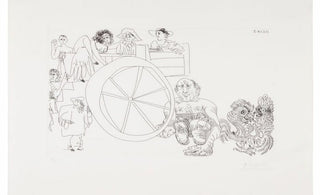
Whether you’re experienced in the art market or not, chances are, you’re familiar with the name Picasso. Picasso is one of the biggest names in the art world, known for his wide range of styles and for revolutionising the Cubism movement.
But is Picasso a blue-chip artist? And what were Picasso’s most famous pieces? Read on to learn more about Pablo Picasso and his artwork, and to find out whether Picasso classes as a blue-chip artist.
What Is A Blue-Chip Artist?
A blue-chip artist is an artist who has a solid history of creating artwork that either retains its value or increases in value. Art investors will consider blue-chip artwork a lucrative and safe investment opportunity.
Blue-chip artists are well-known names in the industry and consistently create art that sells at auctions. Some blue-chip artists include the likes of Andy Warhol, Banksy, Keith Haring and many more notable names.
Blue-Chip vs Old Masters
The term ‘Old Master’ refers to either an artist or a piece of art that was active in Europe prior to the 1800s. Typically, the term is used to describe artists who created works of art between 1300 and 1800, including popular Renaissance artists and great Romantic artists. Art galleries, art academies and art collectors would use the term to describe ‘quality’ historical artwork.
The term began to be widely used in the 18th century and is still used today to describe such artwork. There is much debate as to the criteria that determined an Old Master, including the exact date range and the skill of the artist. Some examples of Old Masters include Leonardo da Vinci, Rembrandt, Michelangelo and many more prominent artists of the time.
In regards to blue-chip artists, however, there is no specific date range that determines whether an artist is considered blue-chip or not. Instead, the term is used to describe any established artist with a track record of sales in the art market.
Who Was Pablo Picasso?
Pablo Picasso was an extremely talented painter, known for using a variety of artistic techniques and experimenting with different art theories. He is one of the most notable figures in the history of art. Picasso spearheaded the Cubism movement and helped to invent collage too.
He brought new techniques to the art world, and ultimately changed the art scene - especially in terms of sculpture. His career spanned many artistic periods, despite the fact that there is debate over some of his later periods.
His work included the Blue Period, the Rose Period, the African-influenced Period, and of course, Cubism, which included both Analytic Cubism and Synthetic Cubism.
Picasso’s Most Famous Artworks
Picasso’s catalogue of work is extremely impressive in terms of both quality and quantity. Throughout Picasso’s career, he painted around 13,500 paintings, as well as 100,000 prints and engravings. Portrait of Dora Maar (1937) is one of Picasso’s most notable paintings. As per the title, the subject of the painting is Dora Maar, one of Picasso’s lovers.
The painting portrays a woman sitting in a chair looking elegant with a stylish jacket and long nails. Portrait of Dora Maar can be found in Musee Picasso, Paris - and is widely known as one of Picasso’s best paintings. Another prominent piece by Picasso is Large Nude in a Red Armchair (1929). Influenced by surrealism, this painting is thought to be a portrait of Picasso’s first wife, Olga.
Olga is said to have animosity towards Picasso following the end of their relationship - and Picasso’s trauma can be seen in this painting. Previously, Olga was portrayed as elegant and sentimental in Picasso’s artwork, but the way Olga was depicted changed over time.
The change can be seen in the colour pallet used - Picasso began to use more muted tones. Large Nude in a Red Armchair can be found in the Merril Collection. The painting was vandalised back in 2012 but was promptly restored. Guernica, 1937 is another of Picasso’s most famous artworks.
This large oil painting is highly regarded as the most powerful anti-war painting, depicting an aerial bombing raid on the town of Guernica during the Spanish Civil War. Guernica can be found in Museo Reina Sofia in Madrid.
What Makes Picasso a Blue Chip Artist?
Many people began to refer to Picasso as one of the Old Masters - however, Picasso would most likely qualify as a blue-chip artist. This is because typically, Old Masters were active around Europe before the 1800s.
However, Picasso created artwork in the late 1800s and throughout the 1900s, until his passing in 1973. The reason Picasso is known as a blue-chip artist is that he produced artwork that would consistently perform well on the art market. His paintings sell for hundreds of millions of dollars - with Les Femmes D’Alger (1955) selling for almost $180,000 in 2015.
Picasso’s pieces can hugely vary in price, selling for as little as £10,000 to millions of pounds. On average, an original Picasso painting costs around $9,500 million at auction.
If you’re looking to invest in blue-chip artworks today, whether it be modern art or contemporary art, contact our team at Grove Gallery today. We can guide you through your art investment journey and ultimately help you to increase your wealth.
Art is a great investment - with the value of art rising by 30% in the last two decades according to the Artprice Global Index. Art investment is a great way to diversify your portfolio and can be used as a hedge against inflation. With Grove Gallery, you can invest in art with as little as £5,000. Begin your art investment journey today.






